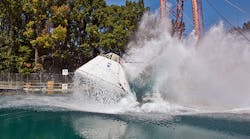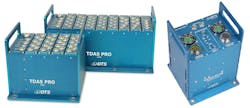NASA’s first test flight and splashdown of an Orion space capsule went well, thanks to three years of testing and simulated splashdowns of a realistic mockup in the agency’s Hydro Impact Basin at its Langley Research Center. To collect information from those preflight tests, NASA wired up an 18,000-lb Orion mockup with 320 strain gauges, pressure sensors, and accelerometers to capture data on the capsule’s responses to landing in water at up to 20 mph.
The data was recorded on 40 TDAS Pro Sims from Diversified Technical Systems, Seal Beach, Calif. Each of these modules collected data from eight sensors or channels, storing up to 100 sec at 10,000 samples per sec per channel on non-volatile flash memory. But the focus was on getting data from the 20-sec. splashdowns.
The data recorders are small, measuring 5.4 × 4.8 × 1.4 inches and weighing 1.7 lb. The rugged devices had shock ratings up to 100 gs. All this let them be mounted close to the sensors they monitored without significantly changing the dynamics of the test. The recorders got the 12 to 15 v of power they needed from Smart Battery packs from DTS, but each unit also had internal back-up batteries, just in case.
After each test, which took up to eight hours of prep time, data was downloaded via USB to a computer. A computer was also used to set up each recorder’s sample rate, trigger, and record time.

